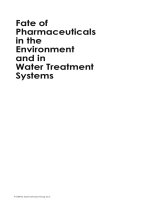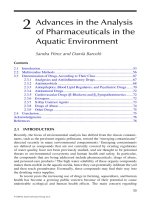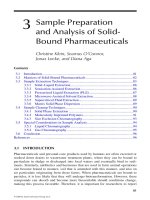08 chapter 08 habitat of HC in sedimentary basins new
Bạn đang xem bản rút gọn của tài liệu. Xem và tải ngay bản đầy đủ của tài liệu tại đây (3.87 MB, 91 trang )
Chapter 08:
THE HABITAT OF
HYDROCARBONS IN
SEDIMENTARY BASINS
HCMUT-2014
1
Content
Introduction
8.1-The Sedimentary Basin Concept
8.2-Sedimentary Basin Classification
8.3-Distribution of petroleum – rich basins.
2
Introduction
There are approximately 600 sedimentary rock basins in the world.
A quarter of them are producing petroleum
Before exploitating in a new area, attemting to locate drillabe prospects, it is
necessery to establish the type of basin, what productive horizons it may
contain and where they may be broadly located
3
•
Even though petroleum reserves can be found in rocks of all ages, most
giant fields and most of the world's reserves occur in sequences, of Late
Mesozoic and Cenozoic age ( Figure 01) . Paleozoic rocks probably had
potential to generate hydrocarbons equal to that of these younger rocks,
but there has been more time in which to destroy all or part of the
petroleum through uplift and erosion (Halbouty et al, 1970).
4
Fig: 01
5
• Worldwide reserves can be related to their location within
a petroleum basin, regardless of its basin type (Figure: 02)
Fig: 02
6
8.1-The Sedimentary Basin Concept
•
A general term for any large area of tectonic origin with a thick accumulation
of sedimentary rocks.
•
A basin is a geological structure with a unique sequence of rocks that are
dissimilar to those outside the basin.
•
A low area with no exterior drainage.
•
Include both depression itself and the thicker-than-everage sediments that fill
it
7
Fig: 03
Idealized pattern of a sedimentary basin
8
Main content:
1. Geometry of Sedimentary Basins
2. Sediment Fill
3. Tectonic Processes and Timing
4. Basin-Forming Mechanisms
5. Sedimentary Basin Classification
10
Geometry of Sedimentary Basins
It is tempting to believe that a sedimentary basin was deepest where its
sediments are thickest, but this is not necessarily true
11
Fig: 05
Non-coincidence of depocenters, topographic low and point of maximum
12
basement subsidence in a land-derived, prograding clastic wedge
Sediment Fill
Basins can be characterized by the sediments that fill them.
They can be dominated by continental, shallow marine, or deep marine sediments,
depending on their elevation and the interplay between the rate of subsidence
and the rate of sedimentation
13
Basin-Forming Mechanisms
•
Basins form as a result of large-scale vertical and horizontal movements
within the earth's upper layers (fig. 06-1) , which can be explained through
the widely accepted theory of plate tectonics.
15
•
The earth's outermost shell is a rigid layer called the lithosphere,
which consists of crust and uppermost mantle. Topographic lows form
on the earth's surface where the crust is thin, and composed of dense
basaltic rocks
•
The rigid lithosphere overlies a less viscous layer called the
asthenosphere
17
Fig: 06-2
The earth's outermost layers
18
Initiation of rifting and ocean floor spreading over
continental crus
Fig: 08 Pre-rift domal bulge
Fig: 09 Initial radial rift
20
Fig: 10 Early separation stage
Fig: 11
21
MODEL OF A DIVERGING PLATE BOUNDARY
Fig: 12
The separated continents are now far apart, and basins develop along their
24
passive margins
MODEL OF SUBDUCTING PLATE MARGIN
Fig: 12
At a subduction zone, the leading edge of one plate overrides another, and the
overridden plate is dragged down into the mantle and consumed
25
MODEL OF A COLLISIONAL PLATE MARGIN, COLLISION BETWEEN
OCEAN PLATE AND A CONTINENTAL MARGIN
Fig: 13
26
MODEL OF A COLLISIONAL PLATE MARGIN,
CONTINENT – CONTINENT COLLISION
Fig: 14
27
Transcurrent faulting along the conver. plate margin in California
Fig: 15
28
8.2-Sedimentary Basin
Classification
•
Many different basin classification schemes have been proposed, as
geological thought has evolved from the geosyncline concept to plate
tectonics.
30
•
Petroleum enrichment, the incidence of giant fields, and the habitat of
petroleum within sedimentary basins can be related to structural,
sedimentological, and geothermal settings, which can be used to
describe a number of petroleum basin types.
•
There are several general ways in which sedimentary basins can be
grouped
31
32









